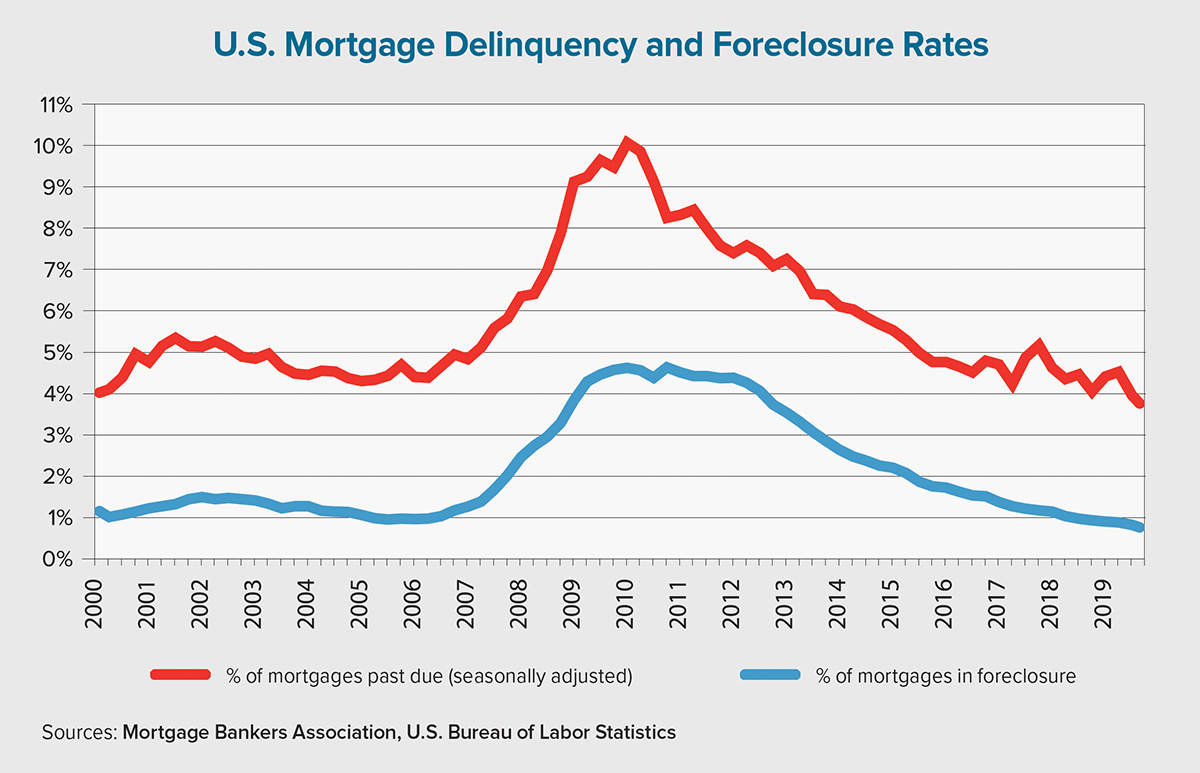Prior to the latter half of 2019, the last time the 30-year fixed mortgage rate hovered at a level below 3.75% was a month before the 2016 presidential election. Rates remained relatively high despite continuous job creation, decent wage growth and the U.S. unemployment rate reaching a 50-year low.
Since the summer of 2019, economic growth has slowed around the world due to trade tensions and other factors. These concerns, along with changed expectations regarding the path for monetary policy, have pushed down the 10-year Treasury rate and, subsequently, mortgage rates. More recently, growing fears around the spread of the coronavirus have led to a further slowdown.
Rates that were nearly a full percentage point lower relative to the previous year have been music to the ears of both consumers and mortgage lenders. The Mortgage Bankers Association (MBA) reported about $2.07 trillion in origination volume in 2019, making it the best for the mortgage industry since 2007 ($2.31 trillion). If this past January and early February are any indication, origination volume for all of 2020 should be robust as well. This past winter, refinances reached their strongest activity levels since the summer of 2013.
How long will mortgage rates stay low? Although there are several factors at play (such as geopolitical uncertainty that could see them fall even further), the MBA’s forecast for this year is for relatively steady rates, with a slow upward trend as the year progresses, to an average of 3.7%. The gradual increase in rates expected later this year, along with a continually shrinking pool of homeowners eligible to refinance, should eventually lead to a slowdown in refinancing. After totaling $796 billion last year, the MBA forecasts refinance volume to decrease to about $665 billion in 2020.
Low rates, a strong labor market and favorable demographics all bode well for another year of solid activity across the purchase market. The MBA is cautiously optimistic that purchase originations will rise 4.1% this year to $1.32 trillion. Combined with refinances, our 2020 forecast is for total originations in the neighborhood of $1.99 trillion.
It bears mentioning that low housing inventory — and its upward pressure on home prices — is frustrating prospective buyers in several parts of the country, especially those with healthy job markets and strong population growth. Although single-family housing starts in 2019 outperformed that of 2018, their overall level still falls short relative to demand.
Recent homebuilding data shows signs of improvement, but years of underproduction is having a detrimental impact on affordability and the psyche of aspiring homebuyers. MBA members have identified the problem and are taking a lead to address it. Last year, in fact, MBA launched an affordable-housing initiative to tackle policy and regulatory solutions that increase housing supply while ensuring that renters and prospective homebuyers have affordable-housing options.
Another trend that has suppressed inventory levels is the fact that Americans are not moving at the rate they had in the past. The most recent Census data shows that less than 10% of the U.S. population moved during a 12-month period spanning 2018 and 2019, less than half the rate at which households moved in 1984-85. The decision to stay put — rather than upgrading or downsizing, or moving for family- or employment-related reasons — correlates significantly to an existing-home supply that is at an all-time low.
There is good news to report, however. As of this past February, mortgage delinquencies track the U.S. unemployment rate closely, and with unemployment at historic lows, it’s no surprise to see the vast majority of households paying their mortgages on time. The mortgage delinquency rate in fourth-quarter 2019 fell to its lowest level (3.77%) since the MBA’s delinquency survey series began in 1979.
Although it remains to be seen if the U.S. economy can maintain its expected annual growth rate of about 2%, consumers and prospective homebuyers continue to be upbeat. Couple that optimism with low mortgage rates and steady job growth, and the conditions are ripe for 2020 to be another strong year for the mortgage industry.
Author
-

Mike Fratantoni is chief economist and senior vice president of research and industry technology at the Mortgage Bankers Association (MBA). He is responsible for overseeing MBA’s industry surveys, benchmarking studies, economic and mortgage origination forecasts, industry-technology efforts, and policy-development research for the single-family and commercial/multifamily markets. Prior to joining MBA, Fratantoni worked in risk management and senior economist roles at Washington Mutual and Fannie Mae.
View all posts






